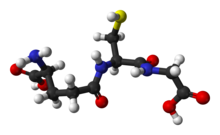
| |

| |

| |
| Names | |
|---|---|
| IUPAC name
γ-Glutamylcysteinylglycine
| |
| Systematic IUPAC name
(2S)-2-Amino-5-({(2R)-1-[(carboxymethyl)amino]-1-oxo-3-sulfanylpropan-2-yl}amino)-5-oxopentanoic acid | |
| Other names
γ-L-Glutamyl-L-cysteinylglycine
(2S)-2-Amino-4-({(1R)-1-[(carboxymethyl)carbamoyl]-2-sulfanylethyl}carbamoyl)butanoic acid | |
| Identifiers | |
3D model (JSmol)
|
|
| Abbreviations | GSH |
| ChEBI | |
| ChEMBL | |
| ChemSpider | |
| DrugBank | |
| ECHA InfoCard | 100.000.660 |
| KEGG | |
| MeSH | Glutathione |
PubChem CID
|
|
| UNII | |
CompTox Dashboard (EPA)
|
|
| |
| |
| Properties | |
| C10H17N3O6S | |
| Molar mass | 307.32 g·mol−1 |
| Melting point | 195 °C (383 °F; 468 K)[1] |
| Freely soluble[1] | |
| Solubility in methanol, diethyl ether | Insoluble[1] |
| Pharmacology | |
| V03AB32 (WHO) | |
Except where otherwise noted, data are given for materials in their standard state (at 25 °C [77 °F], 100 kPa).
| |
Glutathione (GSH, /ˌɡluːtəˈθaɪoʊn/) is an organic compound with the chemical formula HOCOCH(NH2)CH2CH2CONHCH(CH2SH)CONHCH2COOH. It is an antioxidant in plants, animals, fungi, and some bacteria and archaea. Glutathione is capable of preventing damage to important cellular components caused by sources such as reactive oxygen species, free radicals, peroxides, lipid peroxides, and heavy metals.[2] It is a tripeptide with a gamma peptide linkage between the carboxyl group of the glutamate side chain and cysteine. The carboxyl group of the cysteine residue is attached by normal peptide linkage to glycine.
- ^ a b c d Haynes, William M., ed. (2016). CRC Handbook of Chemistry and Physics (97th ed.). CRC Press. p. 3.284. ISBN 9781498754293.
- ^ Pompella A, Visvikis A, Paolicchi A, De Tata V, Casini AF (October 2003). "The changing faces of glutathione, a cellular protagonist". Biochemical Pharmacology. 66 (8): 1499–1503. doi:10.1016/S0006-2952(03)00504-5. PMID 14555227.